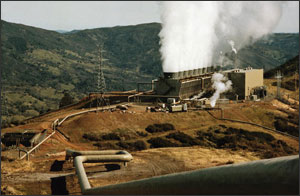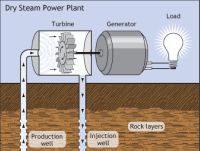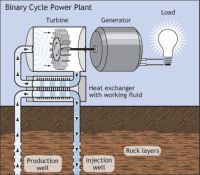|
Geothermal Power Plants
Geothermal power plants use heat deep in the earth to generate steam, which in turn powers generator to generate electricity.
I explain geothermal heat pumps on another page. These systems don’t generate electricity. Rather, they use the fact that at a depth of 10 feet or so the earth’s temperature is stable between 50 and 60 degrees. The heat pump transfers heat from the ground to reduce the energy needed to heat a building. How Geothermal Power Plants WorkGeothermal power plants use the much higher temperatures found deep within the earth to generate electricity. In a way, these power plants are very much like coal or oil powered generators in that the electricity produced by all of them comes from steam driven turbines. The crucial difference is that coal and oil powered plants burn fossil fuels to produce the steam while geothermal plants use the heat of the earth’s core. The earth’s core is extremely hot. How close that heat is from the surface varies widely around the globe. Some areas are more suitable for geothermal power generation than others. It depends on how far from the surface hot areas are located. The Pacific “Rim of Fire”, known for the high incidence of volcanoes is especially suited for geothermal energy production, but many other parts of the world are as well.
The earth’s outer hardened crust has variable thickness, meaning the distance to the underground molten rock is variable. The further the hot material is from the surface, the more difficult it is to tap into it to produce electricity. The concept behind geothermal power generation is simple. Drill a hole deep into the earth to tap into a pressurized area of hot water and steam. Pipe the steam to the surface and use it to drive a turbine to generate electricity. In practice, of course, it’s a tad more complicated. Direct Steam PlantsThe oldest type of geothermal power plant operates pretty much as I described above. Underground collections of hot water and steam are tapped and the steam used to turn turbines. By the way, the concept of generating electricity from the earth’s heat is nothing new. In 1904, Prince Piero Conti of Italy used a direct steam powered generator to light a few light bulbs at the Larderello steam fields. Only seven years later, a commercial power plant was built at the same location.
Today the largest direct steam plant is the Geysers, which is located north of San Francisco. Direct steam plants have a few potential problems. In these plants, the steam driving the turbines may carry small amounts of minerals. That makes the steam very corrosive to the turbine, and also raises the possibility of releasing pollutants into the air. (If you’ve ever smelled sulfur water, you can appreciate that this might not be desirable.) Another problem is that only a limited number of locations have the geological structure necessary to make direct steam power plants feasible. Engineers have developed other types of plants that are more widely applicable and also avoid some of the problems with direct steam plants.
Current plants recover the condensed steam and return it to the earth, greatly reducing possible pollution. Binary Power Plants
The newest system is called a binary power plant. In this system, the geothermal fluid passes through a heat exchanger. In this exchanger, the earth’s heat transfers to another fluid circulating in a closed system. This fluid vaporizes to steam, drives the turbines, then condenses to liquid to begin the cycle again. Such systems avoid exposing the turbine parts to the corrosive steam and virtually eliminate pollution. Binary systems will probably be the most common in the future. Present and Future of Geothermal Power PlantsCurrently, 24 countries have geothermal generating plants. Many more are likely to follow as the technology improves and the problems with oil become more apparent. The US has the highest absolute production, producing almost 3000 megawatts. However, this is a very small percentage of the country’s energy needs. The vast majority of the geothermal plants in the US now are in California and they produce only 5% of that state’s energy needs. The Philippines are currently the second largest producer. There, geothermal produces about one quarter of the country’s energy needs. Around the world, the Earth Policy Institute estimates that at least 39 countries could completely meet their electric needs with geothermal production. Many more can use geothermal as part of their energy mix. All in all, geothermal power plants are a cost effective clean source of electric power that are likely to become more common in the coming decades. LinksClick here to return to Alternative Energy Primer Home from Geothermal Power Plants |
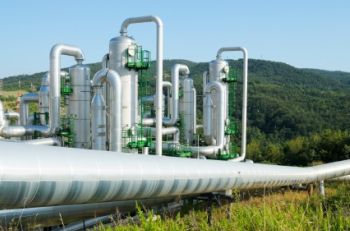
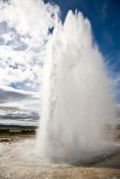 We’ve all heard of hot springs, geysers and volcanoes. These are all examples of situations where the heat from the molten core comes close to the surface. Heat from hot springs has been used directly since ancient times.
We’ve all heard of hot springs, geysers and volcanoes. These are all examples of situations where the heat from the molten core comes close to the surface. Heat from hot springs has been used directly since ancient times.